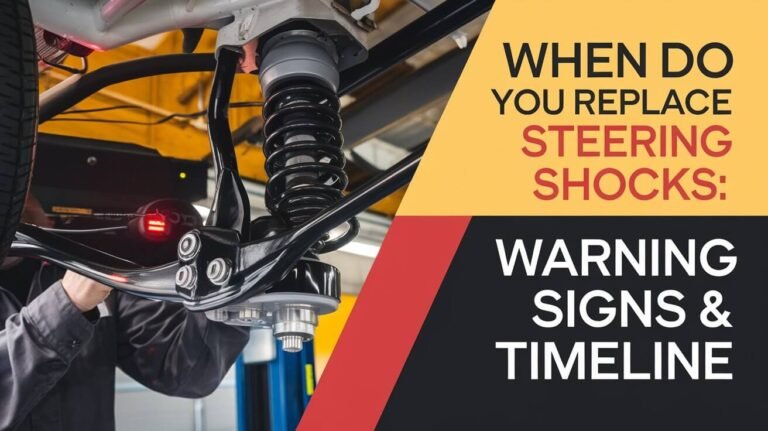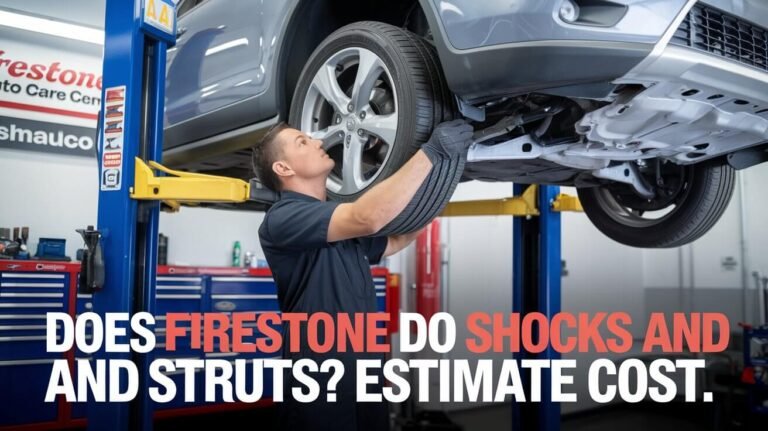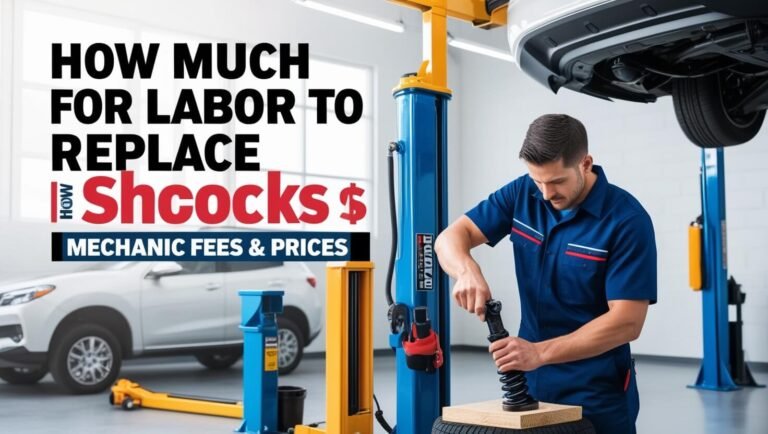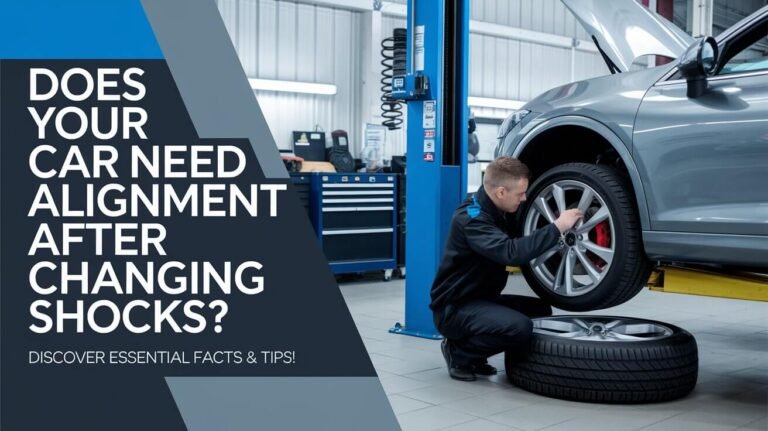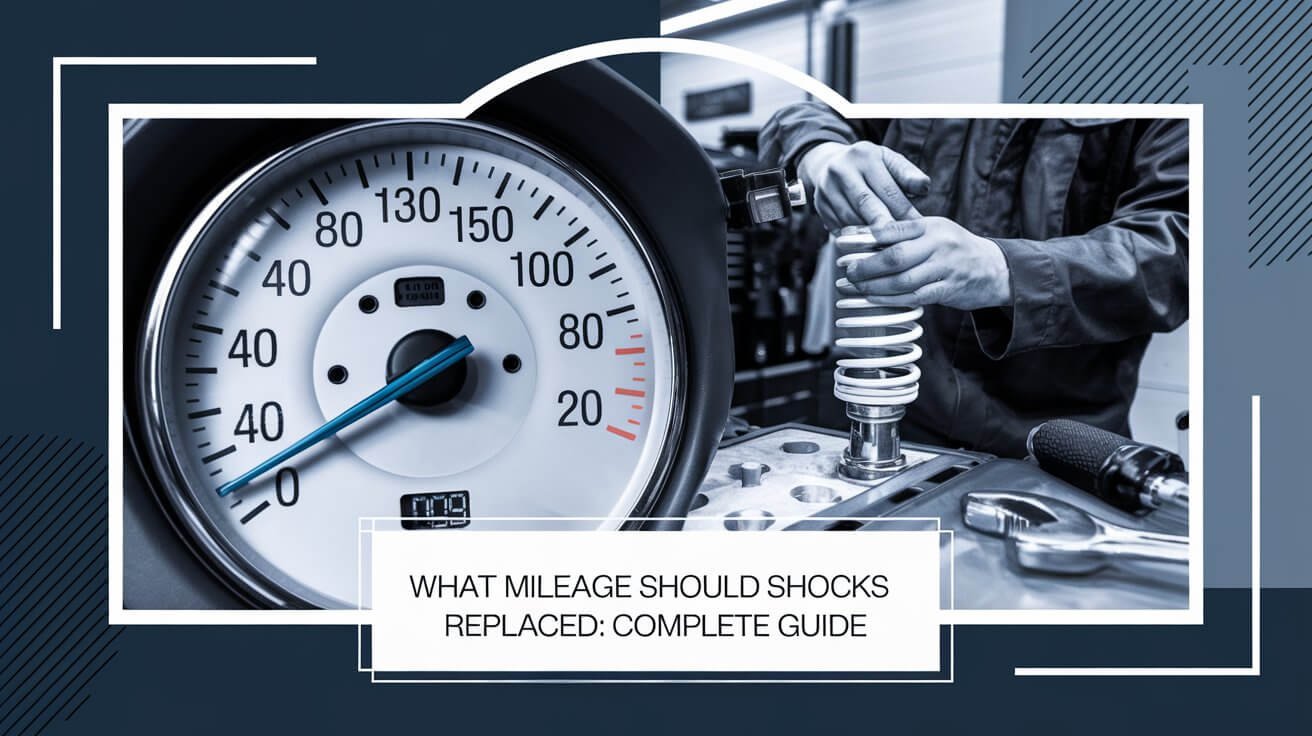
As car owners, we often wonder when it’s time to replace the shock absorbers on our vehicles. These components are key to a smooth and safe ride. But how many miles should they last before needing a swap? This is a crucial question for maintaining our vehicles’ performance and longevity.
Understanding Shock Absorbers and Their Function
Shock absorbers are key to a smooth ride in our cars. They work with other parts to keep the ride stable. They help reduce bouncing and swaying, making the car easier to control.
Basic Components of Vehicle Suspension
At the center of the suspension system are shock absorbers and coil springs. They absorb road bumps together. This keeps the tires in contact with the road, balancing the car and making it comfortable for everyone inside.
Role in Vehicle Stability and Control
Shock absorbers are vital for keeping the car stable and easy to control. They prevent the car from rolling or tilting too much. This is crucial for safe driving, like during emergency stops.
Impact on Ride Quality
Shock absorbers also make driving more comfortable. They smooth out road bumps, making the ride better for everyone. This can reduce driver fatigue on long trips and make daily driving more enjoyable.
| Key Statistic | Value |
|---|---|
| Recommended Mileage for Shock Replacement | 75,000 miles |
| Increase in Stopping Distance with Worn Shocks | Up to 20% |
| Factors Accelerating Shock Wear | Rough roads, frequent hard braking, sharp turns, aggressive driving |
Knowing how important shock absorbers are helps keep our cars safe, performing well, and comfortable. Regular checks and replacing worn shocks ensure a great driving experience for a long time.
What Mileage Should Shocks Be Replaced
As our vehicles get older, it’s important to check our shock absorbers often. Experts say to replace them every 80,000 kilometers (about 50,000 miles) for the best performance and safety.
Shock absorbers help our ride feel smooth and controlled. But, over time, they can wear out. This can make our ride less smooth and our vehicle less stable. Tests show that shocks and struts start to lose their quality by 50,000 miles.
- Shocks move up and down 1,500 to 1,900 times every mile. This adds up to over 75 million cycles in 50,000 miles.
- It’s wise to have a qualified technician check your vehicle every 12,000 miles. They can spot and fix problems with worn shocks and struts.
- If your shocks or struts fail, it’s a safety risk. You should replace them right away if you notice excessive bounce, leaking fluid, or other damage.
The usual time to replace shocks and struts is between 50,000 to 100,000 miles. But, how often you need to replace them can depend on how you drive and how much you use your vehicle. Always talk to a skilled mechanic to figure out the best time for your car.
Differences Between Shocks and Struts
Shocks and struts are key parts of a vehicle’s suspension system. They help absorb road bumps and make the ride smoother. But, they differ in design and where they’re placed on a car.
Structural Design Variations
Shock absorbers work with coil springs to soften road shocks. They use a piston and fluid to control the spring’s movement. This keeps the wheels in touch with the ground.
Struts, on the other hand, are a single unit that combines a shock absorber and a coil spring. They support the vehicle’s structure and dampen movement.
Installation Locations on Vehicles
Most cars have shocks in the back and struts in the front. Struts are important for a car’s stability and handling. They replace parts of the suspension system, offering a direct link between the wheel and the frame.
This design improves the car’s response and stability. Knowing the difference between shocks and struts is key for car maintenance. Always get help from a skilled mechanic to choose and install the right parts for your vehicle.
Key Signs of Worn Shock Absorbers
As our vehicles get older and rack up miles, shock absorbers are key to a smooth ride. Over time, these parts can wear out, impacting our car’s performance and safety. Knowing when to replace them is crucial to keep your vehicle in great shape.
A bumpy ride is a clear sign of worn shocks. Feeling every bump more than usual means it’s time to check your shocks. If your car bounces a lot after hitting a bump, your shocks are not working right.
Leaking fluid on the shocks or struts is another sign. This shows the seals are worn, letting fluid leak out. Uneven tire wear, or “cupping,” can also point to worn shocks. This happens because the suspension can’t control the tires properly.
Feeling your car wobble when braking or turning is a warning sign. If your vehicle feels unstable during these actions, your shocks need attention. They’re not controlling the car’s movement as they should.
Replacing worn shock absorbers is key to your car’s safety and handling. By spotting these signs early, you can keep your car comfortable and controlled for years.
| Warning Sign | Explanation |
|---|---|
| Bumpy, rough ride | Indicates worn shock absorbers, unable to smooth out road imperfections |
| Excessive bouncing after hitting bumps | Shocks are no longer effectively controlling the vehicle’s suspension movement |
| Leaking fluid on shock/strut exteriors | Worn seals allowing the shock’s internal fluid to escape |
| Uneven tire treadwear (cupping) | Suspension’s inability to control tire movement leading to distinctive wear pattern |
| Instability when braking or turning | Worn shocks can’t provide the necessary control and stability |
“Trustworthy professionals recommend inspecting shocks and struts for any needed replacements or repairs when signs of wear are observed.”
Impact of Bad Shocks on Vehicle Safety
Keeping your vehicle’s shock absorbers in good shape is key to your safety on the road. Worn or damaged shocks can affect how well your car handles and stays stable. This makes it harder to control the car when you need to most.
Braking Distance Effects
Worn shocks can’t handle bumps and potholes well, making your car stop farther than usual. Research shows that bad shocks can make stopping up to 20% harder. This is a big problem in emergency stops, where every little bit counts.
Handling and Stability Issues
Bad shocks also mess with your car’s handling and stability. You might feel your car bouncing or swaying too much, making it hard to control, even at slow speeds. This can lead to accidents, which is very dangerous.
Experts say that bad shocks can also wear out other parts of your car, like the steering and brakes. This can cost you more money and make your car even less safe. So, it’s important to check your shocks often and replace them when needed.
Proper Inspection Intervals for Shock Absorbers
Keeping your vehicle’s suspension system in good shape is key for safety and comfort. Shock absorbers should be checked every 20,000 kilometers (about 12,500 miles) or during routine services. At least, annual checks are a must to catch problems early.
Regular shock absorber checks can prevent big issues. Look out for signs like fluid leaks, uneven tire tread, or a bumpy ride. These mean it’s time to fix them for better handling and stability. If steering or braking feels off, it might be a sign of suspension trouble. Get your shocks and struts checked by a pro at the right times.
There’s no set time to replace shock absorbers, but most makers say every 50,000 miles. Yet, how long they last depends on your driving, the vehicle’s weight, and your habits. Regular inspections can help your shocks last longer and keep your ride smooth and safe.
| Inspection Interval | Recommendation |
|---|---|
| Every 20,000 km (12,500 miles) | Inspect shock absorbers and suspension components |
| Annually | Minimum recommended inspection interval |
| Every 50,000 miles | Typical replacement interval for shock absorbers |
“Routine visual inspection is recommended as part of normal maintenance for the suspension system. There is no fixed time limit, in years or mileage, imposed on changing shock absorbers or struts.”
Factors Affecting Shock Absorber Lifespan
Several key factors affect how long our car’s shock absorbers last. Knowing these can help us know when to replace them. This might also help extend their life.
Road Conditions and Driving Habits
Driving on rough roads can wear out shock absorbers fast. Potholes and bumps are big offenders. Our driving style also matters a lot.
Driving hard, like speeding up and braking sharply, puts extra stress on the shocks. This makes them wear out quicker.
Vehicle Weight and Usage Patterns
The weight of our car affects its shock absorbers. Heavy cars or those with lots of cargo or towed trailers stress the suspension more. This makes the shocks wear out faster.
How we use our cars also matters. Driving a lot or going off-road can shorten the life of the shocks.
| Factor | Impact on Shock Absorber Lifespan |
|---|---|
| Road Conditions | Rough roads, potholes, and bumps can accelerate wear |
| Driving Habits | Aggressive acceleration, braking, and cornering increase stress |
| Vehicle Weight | Heavier vehicles and towing/hauling loads put more demands on shocks |
| Usage Patterns | High-mileage driving and off-road adventures can shorten lifespan |
Understanding these factors helps us take better care of our shock absorbers. By watching road conditions, our driving, the car’s weight, and how we use it, we can keep our ride smooth and safe for longer.
Professional vs DIY Shock Replacement
Replacing your vehicle’s shock absorbers can be done two ways: by yourself or by a professional. Many car lovers enjoy the DIY challenge, but it’s safer to let a pro do it. The job is complex, and you need special tools, making professional service the better choice.
Shock absorbers are key to your car’s suspension system. They help your ride stay smooth and your car stable on the road. If you install them wrong or ignore other issues, it can be dangerous. Experts can replace the shocks and check the whole suspension for other problems.
“Replacing shocks is more complex than it might seem. Ensuring proper alignment, torque, and compatibility with the rest of the suspension components is essential for safe and reliable performance. That’s why we always recommend leaving this task to the professionals.”
Getting a professional to replace your shocks might cost more than doing it yourself. But, the benefits last longer. Pros offer a warranty and can find and fix other problems that could harm your new shocks.
When it comes to your car’s shock absorbers, safety and performance are most important. While DIY fans might like the challenge, it’s best to let a pro handle it. This way, your car’s suspension system will work well for many years.
Cost Considerations for Shock Replacement
When thinking about car maintenance costs, shock replacement is key. The price can change based on your car’s make and model, the quality of parts, and the work needed.
Parts and Labor Breakdown
Shock absorbers can cost between $50 and $200 each. Premium brands cost more. Labor adds $100 to $300 per axle for a pro job. Some cars need extra parts like bearing plates, raising the total cost.
Long-term Cost Benefits
Though shock replacement costs upfront, it saves money in the long run. Good shocks and struts improve your car’s safety and performance. This can lead to fewer repairs and a longer car life.
Following the maker’s shock and strut replacement schedule, around 75,000 miles, is wise. This keeps your car running smoothly and safely. It also saves you money in the long term.
Maintenance Tips to Extend Shock Life
To keep our vehicle’s shocks and struts working well, we need to take care of them. Regular tire rotation and keeping tires properly inflated are key. Also, avoid overloading and drive carefully on bumpy roads to prevent damage.
Keeping up with our vehicle’s maintenance is important. This includes checking the alignment regularly. Doing so helps catch problems early and fixes them before they get worse. This helps keep our vehicle’s suspension system, including shocks, in top shape.
Following these maintenance tips, we can make our shocks and struts last longer. This means a smoother ride for a longer time. Taking good care of our vehicle’s suspension is a smart move for our safety and the value of our car.
Questions & Answers
What mileage should shocks be replaced?
Experts say to replace shocks and struts every 80,000 kilometers, or about 50,000 miles. But, you might need to replace them sooner if you drive a lot or on rough roads.
What are the signs of worn shock absorbers?
Worn shocks show up in a few ways. You might feel a bumpy ride or see your car bounce a lot after hitting bumps. Also, look for leaks on the shocks or struts, uneven tire wear, and trouble when braking or turning.
How do bad shocks affect vehicle safety?
Bad shocks can make your car less safe. They can make it harder to stop, cause it to wobble when turning, and mess with safety features like anti-lock brakes and stability control.
How often should shocks and struts be inspected?
It’s smart to check your shocks and struts every 20,000 kilometers, or about 12,500 miles. You should also get them checked during every tire, brake, or alignment service. At least once a year is a good rule of thumb.
What factors affect shock absorber lifespan?
Several things can shorten the life of your shock absorbers. Road conditions, how you drive, the weight of your car, and how much you use it all play a part. Driving hard, hitting lots of bumps, and carrying heavy loads can wear them out faster.
Should I replace shocks myself or have a professional do it?
Some people like to replace their shocks themselves. But, it’s usually better to let a pro do it. They have the right tools and know-how to do it right. Plus, they can check your whole suspension system while they’re at it.
What is the cost of replacing shocks?
The price to replace shocks varies. It depends on your car and the quality of the parts you choose. While it might cost some money upfront, it can save you from bigger expenses down the road.
How can I extend the life of my shock absorbers?
To make your shocks last longer, keep your tires properly inflated and rotate them regularly. Don’t overload your car and drive carefully on rough roads. Also, fix any suspension problems right away. Regular maintenance, like checking your alignment, can help catch issues early.

